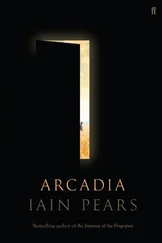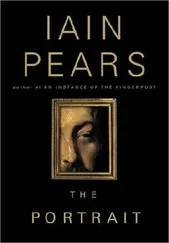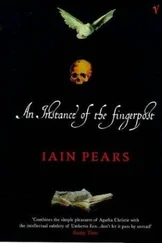The Bernini Bust
Iain Pears
To Dick
Cover Page
Title Page The Bernini Bust Iain Pears
Dedication To Dick
Author’s Note Author’s Note Some of the buildings and paintings in this book exist, others do not, and all the characters are imaginary. There is an Italian art squad in a building in central Rome. However, I have arbitrarily shifted its affiliation from the carabinieri to the polizia, to underline that my account bears no relation to the original.
1
2
3
4
5
6
7
8
9
10
11
12
13
14
15
16
Keep Reading
About the Author
Also by the Author
Copyright
About the Publisher
Some of the buildings and paintings in this book exist, others do not, and all the characters are imaginary. There is an Italian art squad in a building in central Rome. However, I have arbitrarily shifted its affiliation from the carabinieri to the polizia, to underline that my account bears no relation to the original.
Jonathan Argyll lay contentedly on a large slab of Carrara marble, soaking up the mid-morning sun, smoking a cigarette and considering the infinite variety of life. He was not a sun-worshipper – far from it – he was quite proud of his ultraviolet-free complexion, but needs must, despite the risk of wrinkles; his temporary colleagues looked upon his packet of cigarettes with all the approval of vampires presented with a clove of garlic and were prepared to cite innumerable Los Angeles County Clean Air Acts to force him into the open when his nerves required reassurance and sustenance.
He didn’t mind really, although all that moral fervour in such a confined space occasionally made him feel claustrophobic. He would be at the Moresby Museum for only a few days and his stock of moral relativism would last. The when-in-Rome syndrome. A bit longer and he would no doubt be reduced to hanging round the toilets, blowing smoke into air-conditioning vents. But he could survive for a few days.
So he was frequently to be found wandering down the highly expensive, mahogany-coated stairs, through the vast brass and glass doors and into the gentle warmth of California in early summer. And then on to his favourite slab where he performed the joint exercise of having his smoke, watching the world go by, and obscuring the letters which announced to the passerby – not that there were many, this being a part of the world where legs now served mainly a decorative function – that the Arthur M. Moresby Museum of Fine Art was located in the building behind him (9–5 weekdays, 10–4 weekends).
Ahead of him lay what he had come to accept as an almost typical Los Angeles townscape. A broad swathe of luxuriously tended grass – kept going by water piped nearly a thousand miles and then sprinkled in a fine mist – separated the white concrete museum building and the adjacent administrative block from the street. Palm trees sprouted everywhere, doing little but sway in the light wind. Cars drove with painful slowness up and down the wide boulevard ahead. From his well-placed vantage point Argyll could see everything but, apart from himself, there was not another living person visible.
Not that he was paying much attention to the street, the weather or even the palm trees. Life in general was much more on his mind, and beginning to get him down a bit. Success; that was what his presence on the lump of marble signified, and a very mixed blessing it was proving to be. He did his best to look on the bright side; he had, after all, just successfully unloaded a Titian for a client on to the museum behind him for an outrageous sum of money, of which he (or rather his employer) would collect 8.25 per cent. Better still, he had done almost nothing whatever to earn it. A man called Langton had turned up in Rome and said he wanted to buy. Simple as that. Apparently the Moresby considered itself a little short on sixteenth-century Venetian and wanted something by Titian to reinforce its credentials.
Argyll, quick on his feet for about the first time in his professional life, asked for a grossly inflated sum to start off the bargaining. To his immense astonishment, this Langton man had squinted, nodded and said, ‘Fine. Cheap at the price.’ More money than sense, evidently, but who was Argyll to complain? Not even any haggling. Pleased though he was, he still felt slightly let down. People should bargain; it was only proper.
The whole sale went through at such lightning speed he was left breathless. Within two days a contract had turned up. All the normal business of examining and testing and humming and hawing was dispensed with. However, one of the terms of the sale was that the picture should be delivered to the museum free of charge, and that Argyll should be on hand to witness the authentication process – provenance checking, scientific tests, and so on – with museum staff. If there was any dissatisfaction, he would have to take the thing back. More to the point, it was strict payment on delivery – or rather acceptance.
As a point of principle he had protested about this, making vague complaints about honour and gentlemen and the like. No deal. The terms were invariable and set by the owner who, in forty years of collecting, had learnt not to trust an art dealer further than he could throw one. In his heart, Argyll sympathised. Besides, the important thing was to get his hands on the cheque. Essentially, he would have dressed up in Greek national costume and sung sea shanties in a public place if that was what they wanted. Times were hard in the art business.
He had arrived a few days back, alarming the museum staff by bearing the small picture wrapped up in a supermarket bag and transported as hand luggage on the aircraft. It was firmly removed from his care, encased in an especially designed wood and velvet box weighing an extraordinary amount, and carried in an armourplated wagon from the airport to the museum, where a team of six began to study it and another three considered where it might best be hung. Argyll was impressed. He thought one person with a hammer and nail would have done the trick well enough.
But it was the consequences of the sale that bothered him, and cooled off the warm glow of affluent well-being that should, ordinarily, have suffused him. If there was one thing worse than an unhappy employer, it was a happy one, it seemed…His thoughts returned yet again to the unwelcome generosity of Sir Edward Byrnes, proprietor of the Bond Street gallery bearing his name, and Jonathan Argyll’s employer. But, as he knew that no satisfactory decision was likely to result from thinking any more about Byrnes’ offer – instruction, rather – that he return to London after nearly three years in Italy, he was not completely disappointed to be interrupted by the sight of a cab pulling slowly off the street, driving along the driveway of carefully laid, hand-fired terracotta tiles, through the mist keeping the lawn in fine fettle, and finally stopping outside the museum entrance.
The man who emerged was tall, excessively thin and had a carefully cultivated air of aristocratic fastidiousness combined with just a suggestion of aesthetic flair. The first side was indicated by the immaculately fitted suit and watchchain crossing his stomach; the second by a handsome ebony and gold walking stick in his right hand and a lilac handkerchief in his breast pocket.
As the taxi drew away, this man stood still and gazed imperiously about him, very much with the air of someone faintly surprised not to see the full welcoming committee that must be around somewhere. He also looked distinctly annoyed, and Argyll sighed heavily. His day was spoilt already.
Читать дальше












